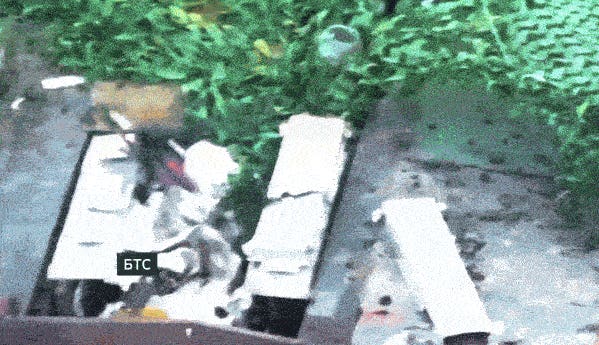Russia’s turtle tanks may look ridiculous with their layers of crude add-on armor—sheet metal, grills and even logs sometimes—but that doesn’t mean they don’t work.
All that extra protection might make the up-armored vehicles slow and difficult to steer, but it can also blunt the effect of the explosive first-person-view drones that are everywhere all the time along the 800-mile front line of Russia’s three-year wider war on Ukraine.
Which is why Ukrainian drone teams are scrambling to find new ways through the layers of do-it-yourself armor. The latest countermeasure is surely the most terrifying for the crews of the various turtle vehicles—not just tanks, but also infantry fighting vehicles, armored personnel carriers and even engineering vehicles.
Some Ukrainian drone operators are slamming thermite-spewing “dragon drones” onto Russian turtle tanks in order to burn through the extra armor with molten incendiary burning as hot as 5,000 degrees Fahrenheit. Soldiers targeted by thermite have 10 seconds to flee the area before suffering fatal burns, the U.S. Army concluded in a 2000 study.
The State Border Guard Service of Ukraine’s Phoenix drone group, deployed just east of Kostyantynivka in eastern Ukraine, graphically demonstrated the thermite tactic while repulsing a large Russian mechanized assault on or just before Sunday.
The Phoenix team knocked out two tanks, two APCs, two IFVs and an engineering vehicle. “The border guards are putting up a worthy resistance,” the State Border Guard Service boasted.
Most of the strikes in the Phoenix group’s Sunday video montage involved traditional explosive FPV drones. But in at least one case, the group slammed a thermite drone—normally deployed for fiery raids on Russian encampments in kindle-heavy treelines—onto the roof of a turtle vehicle. The drone spat its molten metal, quickly burning through the vehicle’s top armor.
It wasn’t the first time a dragon drone had torched a turtle vehicle. That happened back in October under different circumstances. Rather than colliding with the target, the drone in the fall strike hovered overhead, spewing its thermite downward until the tank was a cinder.
The Ukrainian defense ministry congratulated the Phoenix group for its fiery destruction of that Russian assault group. “Great job, warriors,” the ministry stated.
But blowing up and burning one Russian assault group might not stop the rest of the Russians from advancing. Russian troops outnumber Ukrainian troops in most of the most critical sectors. Kostyantynivka is no exception. Destroy one assault group and two more take its place.
It doesn’t help that, with the recent Russian occupation of the ruins of Toretsk, the Phoenix drone group and the adjacent 28th Mechanized Brigade are now defending a five-mile-deep salient east of Kostyantynivka that’s surrounded on three sides by Russian forces.
According to the Ukrainian Center for Defense Strategies, the 28th Mechanized Brigade and the Phoenix group, along with its dragon drones, may soon have to withdraw to the west to avoid encirclement.
Read the full article here





